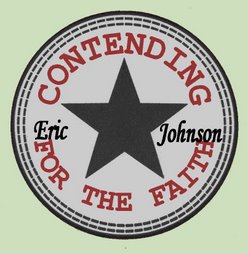Shack Thoughts #2 - God the Father is Not Mrs. Butterworth
As a matter of fact, yes. In this novel Mr. Young portrays God the Father, for the most part, as “a large beaming African-American woman” named Papa.2 It is in this context, where not only the Father is portrayed as a woman but the character of the Holy Spirit is a slight Asian woman named Sarayu, that Mr. Young goes to great lengths in an attempt to justify his creative license in not wanting to reinforce a stereotype that the Father would resemble Gandalf from Lord of the Rings. I too would like to dispel the notion that God the Father is a white-bearded grandfather in the sky, but not by replacing Gandalf with a character who resembles Mrs. Butterworth.
Although this issue of the incarnation of the Father as a woman originally was of high concern, I was shocked at how accustomed to reading feminine pronouns attributed to either the Father or Spirit and how little they seemed to bother me as the book went on. I must have been most of the way through the book before I realized at how desensitized I had become to constantly referring to Mr. Young’s version of the Biblical God as “she”. This was even more infuriating to me when my primary purpose in reading the book was to examine and critique the theological content. How much more would a casual reader, who is engrossed in the story and not intending to examine its theology, be desensitized to the conception of God as a woman? It is both because of the grievous nature of this characterization of God and its desensitizing effect that it has upon the reader that this is the first primary theological issue that I will examine.
There may be few things that are as clearly stated in Scripture as it relates to how we are to picture God than His command in the Decalogue: “You shall not make for yourself an idol, or any likeness of what is in heaven above or on the earth beneath or in the water under the earth.” (Ex 20:4) The word idol, or graven image, may make one think only of worship and so it may be easy to divorce the Mrs. Butterworth-like incarnation from the second commandment because she’s not a statue and there is no real worship service directed at her that occurs in the book (although there are “devotions” where the Shack-Trinity3 talk of their love for one another).
It may further be argued that my objection would not be raised if the Father and Spirit’s characters were male instead of female, and honestly that may have been the case. Others may continue to object because there is not this kind of uproar over the symbolic depiction of Jesus Christ as Aslan in the Narnia series. This objection is true for me personally in that Narnia didn’t cross my radar in such a way so as to raise my concerns, but that doesn’t change the fact that it still may well be, and I think that it is, a violation of God’s Word to depict Him in that way. So in the cases where I have been silent when God is depicted wrongly in fiction, I take responsibility for not responding when I was exposed to it. However, the fact that objections were not raised in the past does not excuse or give a pass to The Shack.
The point is that Exodus 20:4 does not limit objectionable images or likenesses to that of a specific characterization (i.e. Gandalf, Aslan, Papa, etc.) or substance (wood, gold, stone, etc.) and Christians should ardently object to any creaturely characterization of God the Father or the Holy Spirit. In their commentary on this commandment, Keil and Delitzsch compare the command given with Deuteronomy 4:9ff where Moses reminds the people that when they were given the Ten Commandments they “saw no form—only a voice.” (Deuteronomy 4:12) They go on to say that the specific terms used to describe the graven images “are to be understood as referring to symbolical representations of Jehovah.”4 In other words, artistic license – even if it is not for the primary purpose of pagan-type worship – is not a valid shelter for this type of characterization of God the Father or the Holy Spirit that we have present in The Shack.
And I would further add that if we do need to anthropomorphize the Father, Son, or Spirit at any time that we should first and foremost be very careful when we do so. And if we still feel confident to tread these waters and somehow express what God is like, we must do so only in the language and context that the Scriptures present God in. There are plenty of ways that God’s character and attributes are shown in Scripture, and we should be very careful to limit our characterization of Him to the way that He has provided for us.
To close out my thoughts on this particular part of this issue, I want to look at Christ’s words lest people object to my using only using the Law and not the New Testament.
23 “But an hour is coming, and now is, when the true worshipers will worship the Father in spirit and truth; for such people the Father seeks to be His worshipers. 24 "God is spirit, and those who worship Him must worship in spirit and truth.” (John 4:23,24)
I submit that the characterization of God the Father as Mr. Young does in his book violates both verse 23 where we are to worship God in truth and verse 24 where we are plainly told, “God is spirit.” And by definition, spirit is not something that we can put tangible/human substance to. But furthermore, Jesus says that true worshippers will worship in spirit and truth…and the truth that we have is the Scriptures themselves and what they say about God.
“Sanctify them in the truth; Your word is truth.” (John 17:17)
Finally, and briefly, I want to address the fact that the author did choose to have the two members of the Shack-Trinity incarnate as women. First of all, the way in which God has chosen to refer to Himself in the Scriptures is by using masculine pronouns, never feminine. There are a few instances where an action of God is compared to something feminine, but that is hardly a warrant to anthropomorphize or incarnate God as a woman. One of the more common texts that may be brought up to object to what I’m saying is Matthew 23:37 where Jesus is lamenting over the false teaching of the Pharisees,
"Jerusalem, Jerusalem, who kills the prophets and stones those who are sent to her! How often I wanted to gather your children together, the way a hen gathers her chicks under her wings, and you were unwilling.” (Matt 23:37)
You see – Christ Himself depicts Himself in a feminine way in this verse. Well, that is what some would say to add validity to the feminization of God in their overall theology or in their ability to have God be a woman in their fictional book. I, however, would like to point out the phrase “the way a” which is also rendered “as” in various translations. Jesus is not comparing Himself to a hen, He is comparing His desired action to that of a hen – there is a big difference. Furthermore, the feminine characterization is not even of a mother or wife…but of poultry. I certainly hope all Christians would object to a fictional characterization of God as a chicken, but you never know these days.
1 William P. Young, “The Shack” (Los Angeles, Windblown Media, 2007) 88-89.
2 Ibid. 82.
3 I cannot, in good conscience, refer to the characterization of Mr. Young’s god in The Shack simply as the Trinity because that term actually means something in the history of Christianity. I will deal with this at a later time and why I am so adamant about my concerns here, but that is why I must use this term to refer to the Mr. Young’s created god.
4 Keil, Carl Friedrich ; Delitzsch, Franz: Commentary on the Old Testament. Peabody, MA : Hendrickson, 2002, S. 1:396













No comments:
Post a Comment